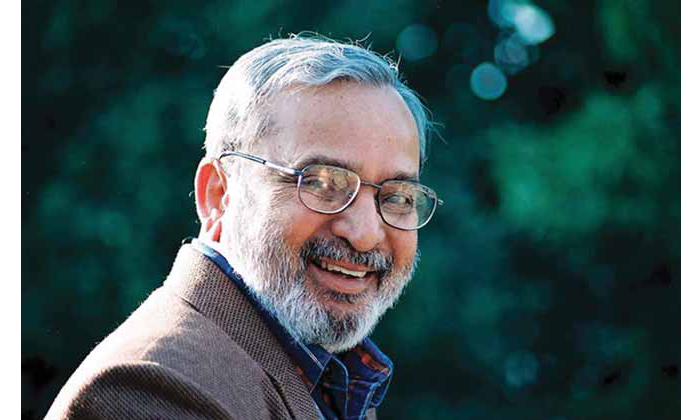For arguments sake, you could say that writers, artists and creators of all things are rebels; they react to things differently than others and build a work that pushes many boundaries – their own, their practice’s, the society’s. By that definition, Jnanapitha awardee Dr U R Ananthamurthy is definitely one.
In his writing and in his politics, he probes the idiosyncrasies and cultural conflicts that afflicted and continues to afflict his caste, his language and the times he lives in. He spearheaded the Navya (new) movement in Kannada literature, a marked rejection of the romantic, lyrical style in favour of more realistic, concise expressions of experiences. Literary history would peg the timeline for this movement down from 1950 to about 1970.
In those twenty years and thereafter, Dr Udupi Rajagopalacharya Ananthamurthy wrote some widely recognized classics like Samskara, Ghatashraddha, Bharatipura and others which heralded new waves in literature, and even cinema when they were later adapted to screen. His Samskara is a prescribed text in many universities in the US and elsewhere. To the common man on Karnataka’s streets, Ananthamurthy is just as well known for his politics, his open criticism of right-wing parties and rightist writers.
The former English professor unapologetically flaunts his Kannada identity and talks of his desire to take Kannada to the world. He did so again when he became the first Kannada writer to be nominated for the Man Booker International Prize this year. Ananthamurthy made the trip to London for the ceremony, despite severe ill health. Back home in Bangalore, he remains too poorly to receive visitors. But in an email conversation, he talked about the nomination, his writing and his identity.
“Ananthamurthy’s novels have primarily been about conflict.”
To him, the nomination was unexpected, given that he can’t tell how friendly his works feel in translation. But an elated Ananthamurthy talks of how a great literary philosopher of the tenth century in his language wrote a workbook in Kannada where he defined the language as bound by two rivers of the land. “Creations in this language may mirror the world. We never thought we were ethnic writers. I felt proud that for a few critical readers in a foreign land I was not an ethnic writer but was one like their own writers raising universally valid questions of what it is to be human,” he says.
In a land where every language other than English is called a vernacular, he believes that there is still a national identity in vernacular language writing; he is not an Indian writer or a Kannada writer alone. “The vernacular writer is like Shakespeare who writes for his immediate audience but the writing has power that the writer may not be conscious of going beyond. The text is not a menu card for the tourist,” he insists. As for why writers like Gabriel Garcia Marquez, Mario Vargas Llosa are more “mainstream” compared to writers in Indian languages, he said that they and their stories were culturally closer to English than any Indian writing in an Indian language could ever be.
Ananthamurthy’s novels have primarily been about conflict. Orthodox ways clash with changing times, the rational and the logical clash with the mysticism of caste politics and age-old religious norms and practices, a character from the village is left to deal with the speed and modernity of cities and bigger towns. In some ways, his probing, “never with the intention of resolving these”, follows the trajectory that Ananthamurthy’s own life, politics and beliefs have taken. Born into a family of small means in a village in Karnataka’s Shimoga district, he went on to study in Mysore, then England before taking up several prestigious positions in academia and elsewhere. He says his craft has evolved over the years, sometimes drastically, each time rethinking his ideologies, but insists that he has never abandoned any of his confusions and conflicts. Writers like D H Lawrence, William Blake and Albert Camus who have been involved in the kind of questions that he has, have been his literary influences. Then there was Lev Tolstoy and Fyodor Dostoyevsky, twelfth century Kannada poets like Akka Mahadevi and Basavanna. His list also includes his own elder contemporaries Shivarama Karanth, Kuvempu, Gopalakrishna Adiga.
Observers of his writing wonder if there has been a softening of his stand in recent times; he is perhaps becoming less vocal in his criticisms of his community, his caste. Ananthamurthy maintains that he is still ambivalent when it comes to cultural questions. What isn’t ambivalent is his emphasis on the Kannada identity. He mooted the idea to Kannada-ize the names of towns in the state, from Bangalore to Bengaluru, from Shimoga to Shivamogga, from Gulbarga to Kalaburgi, among others. He holds on to his view that unless this is done to reestablish and strengthen the local, regional and linguistic identity, we, the people whose language and identity is Kannada, would disappear. What continues to bother him though is that Kannada-ness is not as strong as the Tamil ethos, that we don’t carry Kannada as an identity and as a language with us as much as say, a Malayalee does with his language, his identity. But the octogenarian tells himself that Kannada has always been more inclusive than the others.
You could not write of the ethos of the region, the linguistics, the politics and the literature of Karnataka without acknowledging Ananthamurthy’s— often controversial— influence upon them. In an essay from three decades ago, he talked about everyone being reluctant modernisers, where the West was as much with us as the East. The schizophrenia in this conflict of identity remains, if not more so now in a globalized world. His probing of this conflict is ambivalent, as are his beliefs, when he says, “We may get fatigued by this. The sensitive in Europe get fatigued. The earth may get fatigued and get reduced to a global desert of markets.”


